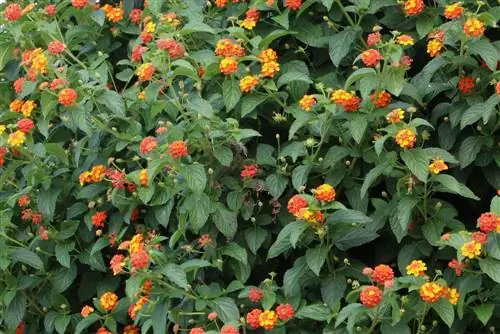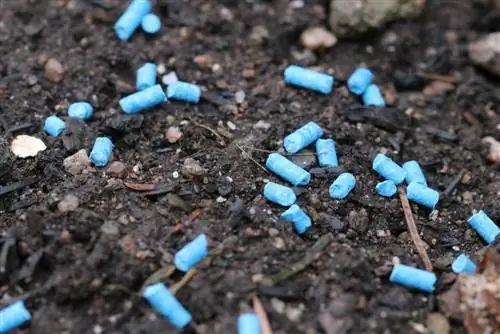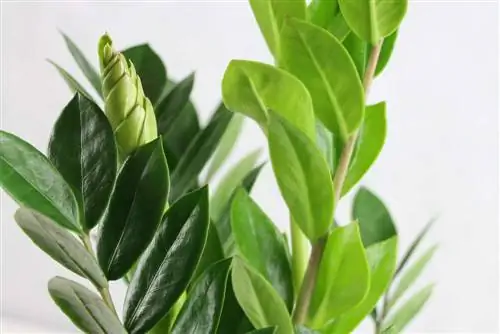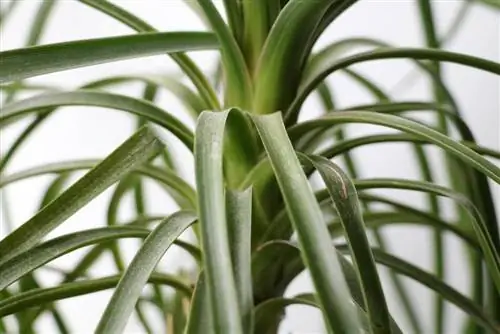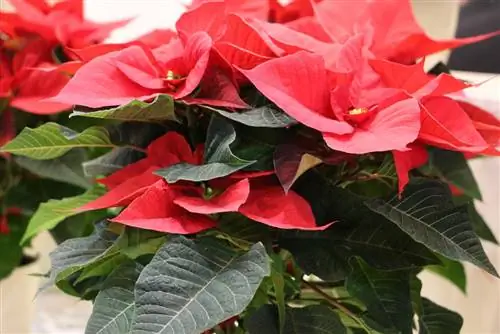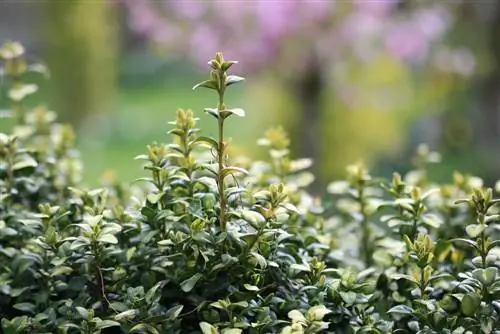- Author admin [email protected].
- Public 2023-12-17 03:39.
- Last modified 2025-06-01 06:48.
Flowers take unusual ways to impress viewers. The lantana is particularly inventive; it gradually changes the color of its flowers during the flowering season. From yellow to orange, for example. This is beautiful to look at and makes him very popular. But does this beauty come at a price? Is lantana poisonous to humans and animals? If so, what should be done?
How poisonous is the lantana?
The three active ingredients lantadene, icterogenin and triterpenes are contained in the poison of the lantana. This combination is very toxic to humans and animals alike. This means that the lantana belongs to the list of the most poisonous plants that we bring into our gardens and on our balconies. The flowers of this plant from the verbena family are, on the one hand, a great ornament, but on the other hand, the risk potential is so high that the purchase of this plant must be carefully considered. In any case, the risk of poisoning must not be underestimated.
These parts of the plant are particularly poisonous
The lantana is highly poisonous from root to tip. However, the concentration of poison is not the same in all parts of the plant, even though they are all poisonous. In particular, its fruits, the small berries, have high concentrations of the toxic mixture. Every year in September and October they are formed in large numbers. As soon as the small flowers have completely faded, the small berries develop and ripen quickly.
Their appearance is similar in shape to blueberries. Their blue-black color is also similar to that of blueberries, which are also called blueberries because of their color. And it is this similarity that can have devastating consequences, especially for young children. It may happen that they mistake the berries for blueberries, pick them and eat them. But while blueberries taste delicious and are he althy, eating lantana berries can be fatal.
Note:
They may not be as tempting as the ripe berries, but the green, unripe berries of the lantana are also highly poisonous at this stage of development.
Cultivation Precautions
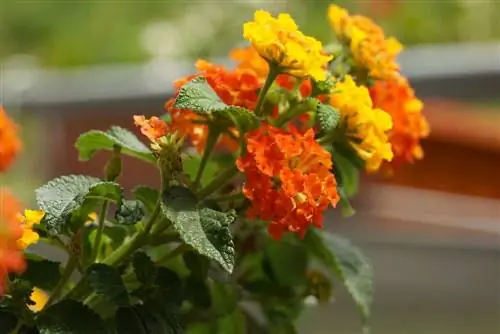
The cultivation of lantana is not prohibited. That's why it can theoretically be bought by anyone to spread joy as a colorful plant decoration with its color change. But does such a poisonous plant belong in our immediate environment? Everyone has to answer this question for themselves. If the decision is in favor of lantana, proper handling of this poisonous plant is a must. This is the only way to reduce the danger to a minimum, although not completely eliminate it.
The following should be taken into account before purchasing a lantana:
- Purchase should be carefully considered
- get comprehensive information about the toxicity
- also inform other affected people
- familiarize yourself with symptoms of poisoning
- know the first steps to take in case of poisoning
- know necessary precautions
Correct handling of this poisonous plant is mandatory when you buy a lantana:
- choose an inaccessible stand
- Always use gloves if the lantana has to be touched
- dispose of cut plant parts immediately and safely
- Remove spent flowers as soon as possible to prevent berry formation
- Keep animals away from the plant
- Never feed plant parts to animals
- ensure that protective measures can be adhered to at all times
- otherwise it would be better to separate from the plant
Tip:
The poison of the lantana is life-threatening. If children and animals can come near him, it's better not to risk anything. Avoiding this poisonous plant is the safest way to avert the danger.
Symptoms of poisoning in humans
If parts of the lantana are eaten despite all safety precautions, the poison begins to take effect and its effects will soon be clearly felt. Lantana camara poison causes numerous symptoms. They are serious, some even life-threatening. The following symptoms occur depending on the severity of the poisoning:
- severe nausea and even vomiting
- Dilation of the pupils
- Diarrhea with traces of blood
- Constipation
- Feeling weak, staggering
- Muscle twitching and uncontrolled movements
- impaired bile drainage
- Liver damage
- altered blood and liver enzymes, with typical features of jaundice
- Skin, mucous membranes and eyeballs show yellowish discoloration
- Shortness of breath
- inflammatory skin rash, when skin comes into contact with the poison
How quickly do symptoms appear?
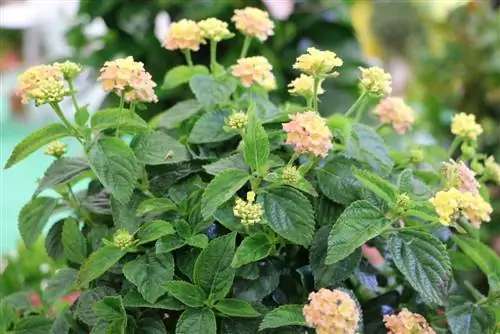
The lantana poison can begin to develop its damaging effects immediately after ingestion or contact. The person affected initially doesn't notice anything. It takes time before the first noticeable symptoms appear. The delay time, the so-called latency period, in the event of lantana poisoning can be 2.5 to 5 hours. Their poison is also phototoxic and develops its full effect under the influence of sunlight.
Attention:
The long latency period could lead you to believe that everything is not so bad. It's better to be on the safe side and take appropriate action immediately.
First measures in case of poisoning of people
Especially if small children eat the poisonous lantana berries, the situation can quickly become life-threatening. Immediate action saves lives, but every single minute can be crucial. If possible, the child should not be left unattended.
- Don't wait until symptoms appear!
- Remove any berries and plant residue that may still be in the child's mouth.
- Give the child plenty to drink. Normal water is best.
- Under no circumstances give the child milk. The milk could possibly promote the absorption of poison.
- If there are external symptoms such as skin irritation, the affected parts of the skin should be rinsed well with water.
- Take the direct route to the hospital with the child.
- Or call the emergency doctor.
- Don't wait to see if the situation improves!
- If the child has already vomited, take some with you. In the hospital, examinations could provide valuable information.
Note:
The poison control center can advise you and give you important information. However, it is only advice and not concrete help. Therefore, do not waste valuable time when it comes to a poisoning as severe as that which Changebeauty can cause.
What can someone else do?
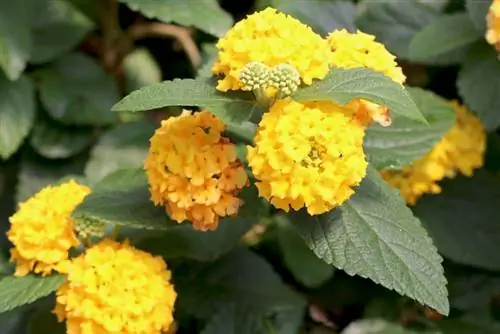
If several people are present, it is of little use if everyone takes care of the child or, if necessary, the adult at the same time. It is much better to carry out other sensible action steps in parallel. This can save valuable time or provide important information. Possible support could look like this:
- call the emergency doctor
- Call a poison control center, especially if no one knows for sure what to do in an emergency.
- get something to drink
- Car pull up now
- Find the address of the hospital
- Pack up leftover vomit
- u. ä.
Lantana and its danger to animals
The pet is the daily companion of many people. They share a living space with the owner and there is hardly an area where the animal cannot access. It's the same with the garden or the balcony. If the pet owner has decided on a lantana, he will hardly be able to keep it away from the animal completely. But the lantana is highly poisonous and life-threatening not only for humans, but also for its four-legged friends. No matter whether the animal is a dog, cat, rabbit, hare, guinea pig or hamster. It is also harmful to livestock, such as cattle. The more they eat, the worse the symptoms of poisoning that occur. If the lethal dose of around 25 grams per kilogram of body weight is reached, death is only a matter of a few days.
- Avoiding lantana is the best protection
- make it difficult for animals to have free access to the plant
- After purchase: Observe whether the plant attracts animals
- Prevent berry formation, remove dead flowers
- Do not feed plant parts to animals
- dispose of cut plant parts immediately and safely
- Do not leave animals unattended near the plant
Symptoms of animal poisoning
If an animal has eaten lantana, the serious consequences will become apparent after a short time. Here too, the poison has a phototoxic effect; exposure to sunlight brings the effect to its full potential. Since lantana thrives on sunny days, the likelihood of this unfavorable situation occurring is high.
The individual symptoms that the poisoned animals show are similar to those in humans:
- Light hypersensitivity
- Liver damage and jaundice
- Disturbances in the movement sequence
- bloody diarrhea or constipation
- Skin rashes.
If the dose of poison is strong, the poisoning can be life-threatening. It is therefore important to react quickly and correctly.
First measures in case of poisoning of animals
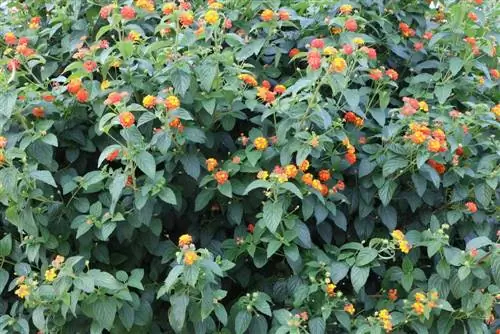
Immediate reaction is also necessary for animals to avoid serious damage
to avoid and above all to save their lives.
- Don't wait until the first symptoms appear.
- Take the first steps as soon as you become aware of consumption.
- Do not classify individual symptoms as harmless.
- Don't wait to see whether the situation improves.
- Remove any remaining leaves or berries from the animal's mouth. Use gloves or put a bag over your hand.
- Take the animal to the vet immediately.
- Get other animals out of the “danger zone”
- Look for a future solution for the poisonous plant.
Destroy the “guilty” lantana?
Anyone or one of their loved ones who has suffered from the poison of this beautiful plant can hardly enjoy it anymore. It is understandable if the lantana is rigorously disposed of under these circumstances. Especially with children, you are never sure whether it won't happen again.
But what about other plants? Hardly anyone is aware of how many plants are poisonous to humans and animals. And most plants really can't tell how toxic they are. Anyone who has children and pets should deal with this now at the latest and then act. So either say goodbye to plants permanently, especially the highly poisonous ones, or educate yourself thoroughly and take precautionary measures.
Poison control centers
Berlin
0 30-19 24 0
Poison emergency call of the Charite / Poison emergency call Berlin
giftnotruf.charite.de
Bonn
02 28-19 24 0
Information Center against Poisoning North Rhine-Westphalia / Poison Center Bonn
Center for Pediatrics University Hospital Bonn
www.gizbonn.de
Erfurt
03 61-73 07 30
Joint Poison Information Center (GGIZ Erfurt) of the states of Mecklenburg-Western Pomerania, Saxony, Saxony-Anh alt and Thuringia in Erfurt
www.ggiz-erfurt.de
Freiburg
07 61-19 24 0
Poisoning Information Center Freiburg (VIZ)
University Hospital Freiburg
www.giftberatung.de
Göttingen
05 51-19 24 0
Poison Information Center-North of the states of Bremen, Hamburg, Lower Saxony and Schleswig-Holstein (GIZ-Nord)
www.giz-nord.de
Homburg/Saar
0 68 41-19 240
Poisoning Information and Treatment Center, Saarland University Hospital and Medical Faculty of Saarland University
www.uniklinikum-saarland.de/giftzentrale
Mainz
0 61 31-19 240
Poison Information Center (GIZ) of the states of Rhineland-Palatinate and Hesse
Clinical Toxicology, University Medical Center Mainz
www.giftinfo.uni-mainz.de
Munich
0 89-19 24 0
Poison emergency call Munich - Department of Clinical Toxicology Klinikum Rechts der Isar - Technical University of Munich
www.toxinfo.med.tum.de
Poison information centers Austria and Switzerland
Vienna/Austria
+43-1-4 06 43 43
Poisoning Information Center (VIZ) - Gesundheit Österreich GmbH
www.goeg.at/Vergiftungsinformation
Zurich/Switzerland
145 (Switzerland)
+41-44-251 51 51 (from abroad)
Swiss Toxicological Information Center
www.toxi.ch

